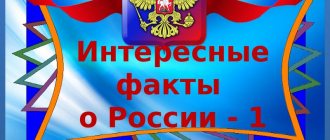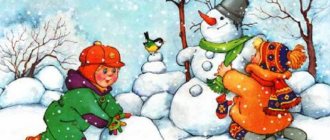Presentation “Russian heroes - epic heroes”
#Teaching and methodological materials #Presentation #All teachers #Educator #Intern student #Preschool education
“Russian heroes - epic writers” Educator: Shirkina V.L.
I’ll tell you about old deeds, Yes, about old things, about experienced ones, Yes, about battles, and about battles, Yes, about heroic deeds!
Bogatyrs Bogatyrs are epic images of heroes of ancient Slavic tribes. The heroes stood guard over Rus', at the outpost. Images of Russian heroes are widely reflected in the works of famous artists, for example, Mikhail Aleksandrovich Vrubel - the decorative panel “Bogatyr”, or Viktor Mikhailovich Vasnetsov - “Bogatyrs” (a painting that he painted for almost twenty years).
The meaning and origin of the word “hero” This word has several meanings: Hero of Russian epics and fairy tales. Defender of the homeland, a warrior distinguished by extraordinary strength, courage, and daring. Tall, well built, strong man. An extraordinary, outstanding person.
In ancient times, back in ancient Rus', very strong people - heroes - stood guard over the borders of our Motherland at the outpost. People composed songs and tales about them, which were called epics. These are the heroes depicted by the artist Vasnetsov in this painting (Vasnetsov’s painting “Bogatyrs” is included). Hero-heroes made the purpose of their lives to serve their Motherland - Rus'. When the heroes gathered together, as we see in Vasnetsov’s painting, they became so strong that it was impossible to defeat them. Bogatyrs have more or less common properties: strength and youth. Although epics often speak of the “old Cossack” Ilya Muromets, here the word old does not mean “burdened with years,” but only mature, experienced in military affairs. In ancient times, back in ancient Rus', very strong people - heroes - stood guard over the borders of our Motherland at the outpost. People composed songs and tales about them, which were called epics. These are the heroes depicted by the artist Vasnetsov in this painting (Vasnetsov’s painting “Bogatyrs” is included). Hero-heroes made the purpose of their lives to serve their Motherland - Rus'. When the heroes gathered together, as we see in Vasnetsov’s painting, they became so strong that it was impossible to defeat them. Bogatyrs have more or less common properties: strength and youth. Although epics often speak of the “old Cossack” Ilya Muromets, here the word old does not mean “burdened with years,” but only mature, experienced in military affairs.
Victor Vasnetsov “Bogatyrs on Horses.” 1896.
Behind the name of each of the epic heroes there is a specific person who lived once upon a time in Rus', and who accomplished his feats only in the epics their characters are embellished by the people. Behind the name of each of the epic heroes there is a specific person who lived once upon a time in Rus', and who accomplished his feats only in the epics their characters are embellished by the people. A storyteller walked from village to village and spoke in a sing-song voice (like a song) about heroic heroes and their exploits. He talked about how it happened. About the deeds and victories of the heroes, about how they defeated evil enemies, defended their land, showed their bravery, courage, ingenuity, and kindness.
Ilya Muromets Ilya Muromets is the most popular hero of epics, a mighty hero. The epic does not know him as a young man, he is an old man with a gray beard. Oddly enough, Ilya Muromets appeared later than his epic younger comrades Dobrynya Nikitich and Alyosha Popovich. His homeland is the city of Murom, the village of Karacharovo. The peasant son, the sick Ilya, “sat sitting on the stove for 30 years and three years.” One day, wanderers came to the house, “walking kaliki.” They healed Ilya, giving him heroic strength. From now on, he is a hero who is destined to serve the city of Kyiv and Prince Vladimir. On the way to Kyiv, Ilya defeats the Nightingale the Robber, puts him in a Toroki and takes him to the princely court. Among other exploits of Ilya, it is worth mentioning his victory over the Idolishch, which besieged Kyiv.
MONUMENT TO ILYA MUROMETS IN THE CITY OF MUROM The image of the ancient Russian hero embodied folk concepts of the high moral qualities that a true hero should have. One of the most important qualities of Ilya Muromets is a sense of justice and awareness of his duty - to stand for the truth. He is ready to go into direct conflict with the prince, with the boyars, when he sees that they are not doing the truth. He is a hero of the whole people, all-Russian, not bound by any class ties. “I am going to serve for the Christian faith and for the Russian land, and for the capital city of Kyiv-grad, for widows, for orphans, for poor people.”
Dobrynya Nikitich The most popular hero of the Russian epic after Ilya Muromets. He embodies those qualities that the people collectively denoted by the word “knowledge”: education, excellent upbringing, knowledge of etiquette, the ability to play the harp, intelligence (Dobrynya plays chess superbly). In addition to the listed qualities, he, like all heroes, is brave and courageous. Since childhood (from the age of 12 or 15), Dobrynya has mastered weapons.
Alyosha Popovich Alyosha Popovich, as the youngest, is the third in importance in the heroic trinity, along with Ilya Muromets and Dobrynya Nikitich. Alyosha Popovich is distinguished not by strength (sometimes his weakness is even emphasized, his lameness is pointed out, etc.), but by courage, daring, onslaught, on the one hand, and resourcefulness, sharpness, cunning, on the other. The birth of Alyosha Popovich was miraculous, reminiscent of the birth of Volkh: it is accompanied by thunder; “Alyoshenka the Wonderful Young,” as soon as he was born, asks his mother for a blessing to walk around the world, not to swaddle him in swaddling clothes, but in chain mail; he can already sit on a horse and wield it, operate with a spear and saber.
Victor Vasnetsov “Bogatyr” 1878. – Defend your homeland, take care of it. - Protect the weak, the poor, the elderly and children. - Be strong, brave, courageous, courageous. - To love your native land, your people, your country and your Motherland. The covenant of the heroes to us, their descendants:
Presentation “Heroes of the Russian Land” presentation for the lesson (reading, grade 4) on the topic
Slide 1
Heroes of the Russian land Glory to the Russian side! Glory to Russian antiquity! And I will begin to tell about this antiquity, So that children can know About the affairs of their native land.
Slide 2
Bogatyrs are heroes of Russian epics who performed feats in the name of the Motherland, people of immeasurable strength, perseverance, courage, endowed with extraordinary intelligence and ingenuity. Victor Vasnetsov “Bogatyrs on Horses.” 1896.
Slide 3
Behind the name of each of the epic heroes there is a specific person who lived once upon a time in Rus', and who accomplished his feats only in the epics their characters are embellished by the people. A storyteller walked from village to village and spoke in a sing-song voice (like a song) about heroic heroes and their exploits. He talked about how it happened. About the deeds and victories of the heroes, about how they defeated evil enemies, defended their land, showed their bravery, courage, ingenuity, and kindness. Konstantin Vasiliev “Russian Knight”
Slide 4
The storyteller said so: I’ll tell you about old deeds, Yes, about old things, about experienced ones, Yes, about battles, and about battles, Yes, about heroic deeds!
Slide 5
This is how the epic was composed. Among the Russian people, epic stories about mighty heroes have been passed down from mouth to mouth for many centuries, from grandfather to grandson. The epics reflected the life of the Russian people, which was very difficult in Rus'. Almost every epic mentions Kyiv, Rus', Russian land, Motherland, Russia - what beautiful and mysterious words. Rus. A very short word. It came to us from hoary antiquity and remained with us forever.
Slide 6
Andrey Ryabushkin “Mikula Selyaninovich”, 1895 MIKULA SELYANINOVICH He is a representative of agricultural life, possessing not quantitative, like Svyatogor, but qualitative strength, which can be called endurance. The epic says this about him: He will turn out a stone with one hand, and with both hands he will knock down a bull. His name is Mikula Selyaninovich. Mikula Selyaninovich helped defend his land from enemies, but did not give up his agricultural work. He said: “Who will feed Rus' then?” Found in 2 epics: about Svyatogor and about Volga Svyatoslavich.
Slide 7
Georgy Yudin Mikula Selyaninovich and Svyatogor. Konstantin Vasiliev “Meeting of Volga and Mikula Selyaninovich”
Slide 8
Andrey Ryabushkin “Volga Vseslavyevich or Volkh Vseslavich”, 1895. The main epics about Volga tell about his miraculous birth from a serpent, his campaign in India and his confrontation with Mikula Selyaninovich. Volga Svyatoslavovich, a werewolf and hunter, is one of the most ancient heroes. VOLGA VSESLAVIEVICH
Slide 9
Konstantin Vasiliev "Volga Svyatoslavovich"
Slide 10
The most famous epic heroes: Ilya Muromets, Alyosha Popovich, Dobrynya Nikitich. V.M. Vasnetsov “Bogatyrs”.
Slide 11
- a representative of all Russian heroes and in the eyes of the people is a representative of the peasant class. Ilya is distinguished by enormous strength, which other younger heroes do not possess, but this strength is not quantitative, but qualitative, and physical strength is accompanied by moral strength: calmness, fortitude, simplicity, fatherly care, restraint, complacency, modesty, independence of character. ILYA MUROMETS N. Karazin Illustration for the epic “Ilya Muromets” Ilya asks his parents for a blessing to serve Prince Vladimir.
Slide 12
Monument to Ilya Muromets in Murom.
Slide 13
Andrei Ryabushkin “Alyosha Popovich”, 1895 Alyosha Popovich is closely connected with Ilya Muromets and Dobrynya Nikitych: he is in constant relations with them. In addition, between Alyosha and Dobrynya there is a striking similarity not in characters, but in adventures and some other circumstances of their lives; namely, the epics about the snake fight between Dobrynya and Alyosha are almost completely similar to each other. ALESHA POPOVICH
Slide 14
Viktor Vasnetsov “Fight of Dobrynya Nikitich with the seven-headed Serpent Gorynych” 1913-1918 - he is a Sagittarius and an excellent fighter, he is reasonable in speeches, in life he was quiet and calm. Dobrynya Nikitich has long been compared by many with the chronicle Dobrynya, Vladimir’s uncle, and considered him a representative of high Russian society, a type of prince-combatant. NIKITICH
Slide 15
Victor Vasnetsov “Bogatyr” 1878. – Defend your homeland, take care of it. — — Protect the weak, the poor, the elderly and children. - Be strong, brave, courageous, courageous. - To love your native land, your people, your country and your Motherland. The covenant of the heroes to us, their descendants:
Slide 16
And strong, mighty heroes in glorious Rus'! Don't allow enemies to gallop across our Earth! Do not trample their horses on the Russian Land. Do not eclipse our red sun for them! Rus' stands a century - it does not waver! And it will stand for centuries without moving! But we must not forget the legends of antiquity. Glory to Russian antiquity! Glory to the Russian side!






